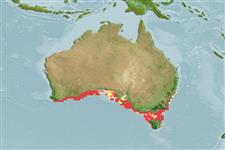Common names from other countries
Environment: milieu / climate zone / depth range / distribution range
Écologie
; profondeur 0 - 50 m. Temperate, preferred 15°C (Ref. 107945); 32°S - 43°S, 116°E - 153°E
Indo-West Pacific: Endemic to Australia, from Fremantle, Western Australia to Angourie, New South Wales and south to Blubber Head, Tasmania.
Length at first maturity / Taille / Poids / Âge
Maturity: Lm ?, range 3 - 9 cm Max length : 20.0 cm SHW mâle / non sexé; (Ref. 93239)
Adults live on rocky surfaces, hidden in crevices, caves, fissures or vertical rock faces (Ref. 93239). Frequent in estuaries, in natural beds on a shingle and mud bank (Ref. 63218).
Broadcast spawners. Life cycle: Embryos develop into lecithotrophic larvae and later into juvenile veligers before becoming fully grown adults. Also Ref. 833.
The Academy of Natural Sciences. 2006. (Ref. 3204)
Statut dans la liste rouge de l'IUCN (Ref. 130435)
statut CITES (Ref. 108899)
Not Evaluated
Not Evaluated
Utilisations par l'homme
Pêcheries: commercial
FAO - Aquaculture: production; pêcheries: landings | FishSource | Sea Around Us
Outils
Sources Internet
Estimates based on models
Preferred temperature
(Ref.
115969): 14.2 - 18.4, mean 16.4 (based on 84 cells).
Résilience
Milieu, temps minimum de doublement de population : 1,4 à 4,4 années (K=0.29; tm=4.5).
Prior r = 0.57, 95% CL = 0.37 - 0.85, Based on 3 data-limited stock assessments.
Vulnérabilité
Low vulnerability (10 of 100).
